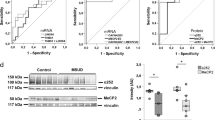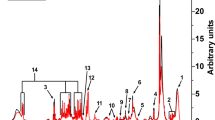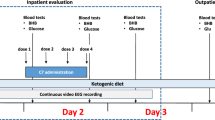Abstract
Inborn errors of metabolism (IEMs) are genetic disorders characterized by dysfunction of an enzyme or other protein involved in cellular metabolism. In most cases, IEMs involve the nervous system. The first clinical symptoms of IEMs usually present in infancy, but in an unknown proportion of cases they can appear in adolescence or adulthood. In this Review, we focus on treatable IEMs, presenting acutely or chronically, that can be diagnosed in an adult neurology department. To make our presentation readily usable by clinicians, the Review is subdivided into eight sections according to the main clinical presentations: emergencies (acute encephalopathies and strokes), movement disorders, peripheral neuropathies, spastic paraparesis, cerebellar ataxia, psychiatric disorders, epilepsy and leukoencephalopathies. Our aim is to present simple guidelines to enable neurologists to avoid overlooking a treatable metabolic disease.
This is a preview of subscription content, access via your institution
Access options
Subscribe to this journal
Receive 12 print issues and online access
$209.00 per year
only $17.42 per issue
Buy this article
- Purchase on Springer Link
- Instant access to full article PDF
Prices may be subject to local taxes which are calculated during checkout
Similar content being viewed by others
References
Jimenez-Sanchez G et al. (2001) Human disease genes. Nature 409: 853–855
Gray RG et al. (2000) Inborn errors of metabolism as a cause of neurological disease in adults: an approach to investigation. J Neurol Neurosurg Psychiatry 69: 5–12
Saudubray JM et al. (2006) Clinical approach to treatable inborn metabolic diseases: an introduction. J Inherit Metab Dis 29: 261–274
Saudubray JM et al. (2006) A clinical approach to inherited metabolic disorders. In Inborn Metabolic Diseases: Diagnosis and Treatment, 3–48 (Eds Saudubray JM et al.) Berlin: Springer-Verlag
Saudubray JM and Charpentier C (2001) Clinical phenotypes: Diagnosis/Algorithms. In The Metabolic and Molecular Bases of Inherited Diseases, edn 8, 1327–1407 (Eds Scriver CR et al.) New York: McGraw Hill
DiMagno EP et al. (1986) Ornithine transcarbamylase deficiency—a cause of bizarre behavior in a man. N Engl J Med 315: 744–747
Arn PH et al. (1990) Hyperammonemia in women with a mutation at the ornithine carbamoyltransferase locus: a cause of postpartum coma. N Engl J Med 322: 1652–1655
Bogdanovic MD et al. (2000) Late onset heterozygous ornithine transcarbamylase deficiency mimicking complex partial status epilepticus. J Neurol Neurosurg Psychiatry 69: 813–815
Oechsner M et al. (1998) Hyperammonaemic encephalopathy after initiation of valproate therapy in unrecognised ornithine transcarbamylase deficiency. J Neurol Neurosurg Psychiatry 64: 680–682
Nassogne MC et al. (2001) Hereditary metabolic causes of stroke and pseudo-stroke in adulthood. Rev Med Interne 22 (Suppl 3): S338–S346
Eather G et al. (2006) Carbamyl phosphate synthase deficiency: diagnosed during pregnancy in a 41-year-old. J Clin Neurosci 13: 702–706
Cowley DM et al. (1998) Adult-onset arginase deficiency. J Inherit Metab Dis 21: 677–678
Enns GM et al. (2005) Postpartum “psychosis” in mild argininosuccinate synthetase deficiency. Obstet Gynecol 105: 1244–1246
Pasquier F et al. (1994) Methylenetetrahydrofolate reductase deficiency revealed by a neuropathy in a psychotic adult. J Neurol Neurosurg Psychiatry 57: 765–766
Freeman JM et al. (1975) Folate-responsive homocystinuria and “schizophrenia”. A defect in methylation due to deficient 5,10-methylenetetrahydrofolate reductase activity. N Engl J Med 292: 491–496
Walk D et al. (1994) Intermittent encephalopathy, reversible nerve conduction slowing, and MRI evidence of cerebral white matter disease in methylenetetrahydrofolate reductase deficiency. Neurology 44: 344–347
Haworth JC et al. (1993) Symptomatic and asymptomatic methylenetetrahydrofolate reductase deficiency in two adult brothers. Am J Med Genet 45: 572–576
Roze E et al. (2003) Neuropsychiatric disturbances in presumed late-onset cobalamin C disease. Arch Neurol 60: 1457–1462
Kauppinen R (2005) Porphyrias. Lancet 365: 241–252
Crimlisk HL (1997) The little imitator—porphyria: a neuropsychiatric disorder. J Neurol Neurosurg Psychiatry 62: 319–328
Asola MR (1995) A diver unconscious after gastroenteritis. Lancet 346: 1338
Hall DA and Ringel SP (2004) Adult nonketotic hyperglycinemia (NKH) crisis presenting as severe chorea and encephalopathy. Mov Disord 19: 485–486
Livingstone IR et al. (1984) Familial intermittent ataxia with possible X-linked recessive inheritance: two patients with abnormal pyruvate metabolism and a response to acetazolamide. J Neurol Sci 64: 89–97
Feillet F et al. (2003) Adult presentation of MCAD deficiency revealed by coma and severe arrythmias. Intensive Care Med 29: 1594–1597
Ozand PT et al. (1998) Biotin-responsive basal ganglia disease: a novel entity. Brain 121: 1267–1279
Pendlebury ST et al. (2004) Strokelike presentation of Wilson disease with homozygosity for a novel T766R mutation. Neurology 63: 1982–1983
Mudd SH et al. (1985) The natural history of homocystinuria due to cystathionine beta-synthase deficiency. Am J Hum Genet 37: 1–31
Kelly PJ et al. (2003) Stroke in young patients with hyperhomocysteinemia due to cystathionine beta-synthase deficiency. Neurology 60: 275–279
Visy JM et al. (1991) Homocystinuria due to 5,10-methylenetetrahydrofolate reductase deficiency revealed by stroke in adult siblings. Neurology 41: 1313–1315
Mitsias P and Levine SR (1996) Cerebrovascular complications of Fabry's disease. Ann Neurol 40: 8–17
Rolfs A et al. (2005) Prevalence of Fabry disease in patients with cryptogenic stroke: a prospective study. Lancet 366: 1794–1796
Fellgiebel A et al. (2006) CNS manifestations of Fabry's disease. Lancet Neurol 5: 791–795
Dinopoulos A et al. (2005) Atypical variants of non-ketotic hyperglycinemia. Mol Genet Metab 86: 61–69
Zeng WQ et al. (2005) Biotin-responsive basal ganglia disease maps to 2q36.3 and is due to mutations in SLC19A3. Am J Hum Genet 77: 16–26
Kitzberger R et al. (2005) Wilson disease. Metab Brain Dis 20: 295–302
Mellick G et al. (2004) Late-onset presentation of pyruvate dehydrogenase deficiency. Mov Disord 19: 727–729
Van Maldergem L et al. (2002) Coenzyme Q-responsive Leigh's encephalopathy in two sisters. Ann Neurol 52: 750–754
Lopez LC et al. (2006) Leigh syndrome with nephropathy and CoQ10 deficiency due to decaprenyl diphosphate synthase subunit 2 (PDSS2) mutations. Am J Hum Genet 79: 1125–1129
Ramaekers VT et al. (2005) Autoantibodies to folate receptors in the cerebral folate deficiency syndrome. N Engl J Med 352: 1985–1991
Berg D and Hochstrasser H (2006) Iron metabolism in Parkinsonian syndromes. Mov Disord 21: 1299–1310
Segawa M et al. (2003) Autosomal dominant guanosine triphosphate cyclohydrolase I deficiency (Segawa disease). Ann Neurol 54 (Suppl 6): S32–S45
Schiller A et al. (2004) Long-term course of L-dopa-responsive dystonia caused by tyrosine hydroxylase deficiency. Neurology 63: 1524–1526
Friedman J et al. (2006) Dopa-responsive hypersomnia and mixed movement disorder due to sepiapterin reductase deficiency. Neurology 67: 2032–2035
Tanaka K et al. (1987) Dihydrobiopterin synthesis defect: an adult with diurnal fluctuation of symptoms. Neurology 37: 519–522
Pogson D (1997) Issues for consideration in dihydropteridine reductase (DHPR) deficiency: a variant form of hyperphenylalaninaemia. J Intellect Disabil Res 41: 208–214
Sedel F et al. (2006) Dihydropteridine reductase deficiency: levodopa's long-term effectiveness without dyskinesia. Neurology 67: 2243–2245
Kempster PA et al. (1988) Dystonia in homocystinuria. J Neurol Neurosurg Psychiatry 51: 859–862
Tayebi N et al. (2003) Gaucher disease with parkinsonian manifestations: does glucocerebrosidase deficiency contribute to a vulnerability to parkinsonism? Mol Genet Metab 79: 104–109
Verrips A et al. (2000) Cerebrotendinous xanthomatosis: controversies about nerve and muscle: observations in ten patients. Neuromuscul Disord 10: 407–414
Illingworth DR et al. (1980) Abetalipoproteinemia: report of two cases and review of therapy. Arch Neurol 37: 659–662
Jung KH et al. (2005) Wilson disease with an initial manifestation of polyneuropathy. Arch Neurol 62: 1628–1631
Wolf B et al. (1998) Delayed-onset profound biotinidase deficiency. J Pediatr 132: 362–365
Mitchell G et al. (1990) Neurologic crises in hereditary tyrosinemia. N Engl J Med 322: 432–437
Debray FG et al. (2006) Intermittent peripheral weakness as the presenting feature of pyruvate dehydrogenase deficiency. Eur J Pediatr 165: 462–466
Wills AJ et al. (2001) Refsum's disease. QJM 94: 403–406
Ibdah JA et al. (1998) Mild trifunctional protein deficiency is associated with progressive neuropathy and myopathy and suggests a novel genotype–phenotype correlation. J Clin Invest 102: 1193–1199
De Koning TJ et al. (1999) Continuing education in neurometabolic disorders—serine deficiency disorders. Neuropediatrics 30: 1–4
Baumgartner MR et al. (1998) Clinical approach to inherited peroxisomal disorders: a series of 27 patients. Ann Neurol 44: 720–730
Ferdinandusse S et al. (2000) Mutations in the gene encoding peroxisomal alpha-methylacyl-CoA racemase cause adult-onset sensory motor neuropathy. Nat Genet 24: 188–191
Powers JM et al. (2001) Neurological and neuropathologic heterogeneity in two brothers with cobalamin C deficiency. Ann Neurol 49: 396–400
Salvi FM et al. (2001) Clinical and molecular findings in hyperornithinemia–hyperammonemia–homocitrullinuria syndrome. Neurology 57: 911–914
Kasim S et al. (2001) Phenylketonuria presenting in adulthood as progressive spastic paraparesis with dementia. J Neurol Neurosurg Psychiatry 71: 795–797
McCombe PA et al. (1992) Spasticity and white matter abnormalities in adult phenylketonuria. J Neurol Neurosurg Psychiatry 55: 359–361
Hansen FJ and Blau N (2005) Cerebral folate deficiency: life-changing supplementation with folinic acid. Mol Genet Metab 84: 371–373
Verrips A et al. (1999) Spinal xanthomatosis: a variant of cerebrotendinous xanthomatosis. Brain 122: 1589–1595
Tokatli A et al. (1997) Biotinidase deficiency with neurological features resembling multiple sclerosis. J Inherit Metab Dis 20: 707–708
Patel K et al. (1995) Dopa responsive dystonia. Arch Dis Child 73: 256–257
Furukawa Y et al. (2001) Dopa-responsive dystonia simulating spastic paraplegia due to tyrosine hydroxylase (TH) gene mutations. Neurology 56: 260–263
Martinello F et al. (1998) Supplemental therapy in isolated vitamin E deficiency improves the peripheral neuropathy and prevents the progression of ataxia. J Neurol Sci 156: 177–179
Homer VM et al. (2005) Mental retardation and ataxia due to normotriglyceridemic hypobetalipoproteinemia. Ann Neurol 58: 160–163
Verrips A et al. (2000) Clinical and molecular genetic characteristics of patients with cerebrotendinous xanthomatosis. Brain 123: 908–919
Lamperti C et al. (2003) Cerebellar ataxia and coenzyme Q10 deficiency. Neurology 60: 1206–1208
Bressman S et al. (1986) Biotin-responsive encephalopathy with myoclonus, ataxia, and seizures. Adv Neurol 43: 119–125
Ryan MM et al. (2002) Homocystinuria presenting as psychosis in an adolescent. J Child Neurol 17: 859–860
Akil M et al. (1991) The psychiatric presentations of Wilson's disease. J Neuropsychiatry Clin Neurosci 3: 377–382
Berginer VM et al. (1988) Psychiatric disorders in patients with cerebrotendinous xanthomatosis. Am J Psychiatry 145: 354–357
Abbott MH et al. (1987) Psychiatric manifestations of homocystinuria due to cystathionine beta-synthase deficiency: prevalence, natural history, and relationship to neurologic impairment and vitamin B6-responsiveness. Am J Med Genet 26: 959–969
Turpin JC and Baumann N (2003) Presenting psychiatric and cognitive disorders in adult neurolipidoses. Rev Neurol (Paris) 159: 637–647
Brockmann K et al. (2001) Autosomal dominant glut-1 deficiency syndrome and familial epilepsy. Ann Neurol 50: 476–485
Klepper J et al. (2001) Autosomal dominant transmission of GLUT1 deficiency. Hum Mol Genet 10: 63–68
Winkelman MD et al. (1983) Non-infantile neuronopathic Gaucher's disease: a clinicopathologic study. Neurology 33: 994–1008
Winkler AS et al. (2005) Neuropsychiatric porphyria in patients with refractory epilepsy: report of three cases. J Neurol Neurosurg Psychiatry 76: 380–383
Dening TR et al. (1988) Wilson's disease and epilepsy. Brain 111: 1139–1155
Arlazoroff A et al. (1991) Epileptic seizure as a presenting symptom of cerebrotendinous xanthomatosis. Epilepsia 32: 657–661
Clayton PT (2006) B6-responsive disorders: a model of vitamin dependency. J Inherit Metab Dis 29: 317–326
Filley CM and Kleinschmidt-DeMasters BK (2001) Toxic leukoencephalopathy. N Engl J Med 345: 425–432
Barkhof F et al. (2000) Cerebrotendinous xanthomatosis: the spectrum of imaging findings and the correlation with neuropathologic findings. Radiology 217: 869–876
Boxer AL et al. (2005) Executive dysfunction in hyperhomocystinemia responds to homocysteine-lowering treatment. Neurology 64: 1431–1434
Bahr O et al. (2002) Adult onset glutaric aciduria type I presenting with a leukoencephalopathy. Neurology 59: 1802–1804
Kulkens S et al. (2005) Late-onset neurologic disease in glutaryl-CoA dehydrogenase deficiency. Neurology 64: 2142–2144.
Thompson AJ et al. (1993) Brain MRI changes in phenylketonuria: associations with dietary status. Brain 116: 811–821.
Author information
Authors and Affiliations
Corresponding author
Ethics declarations
Competing interests
The authors declare no competing financial interests.
Supplementary information
Supplementary Table 1
Proposed treatments in adult neurometabolic diseases (DOC 102 kb)
Rights and permissions
About this article
Cite this article
Sedel, F., Lyon-Caen, O. & Saudubray, JM. Therapy Insight: inborn errors of metabolism in adult neurology—a clinical approach focused on treatable diseases. Nat Rev Neurol 3, 279–290 (2007). https://doi.org/10.1038/ncpneuro0494
Received:
Accepted:
Issue Date:
DOI: https://doi.org/10.1038/ncpneuro0494
This article is cited by
-
Psychiatric manifestations in cerebrotendinous xanthomatosis
Translational Psychiatry (2013)
-
Maladies héréditaires du métabolisme en réanimation: explorations, stratégies diagnostiques et principes thérapeutiques
Réanimation (2012)
-
A urinary cause of coma
Journal of Neurology (2011)



